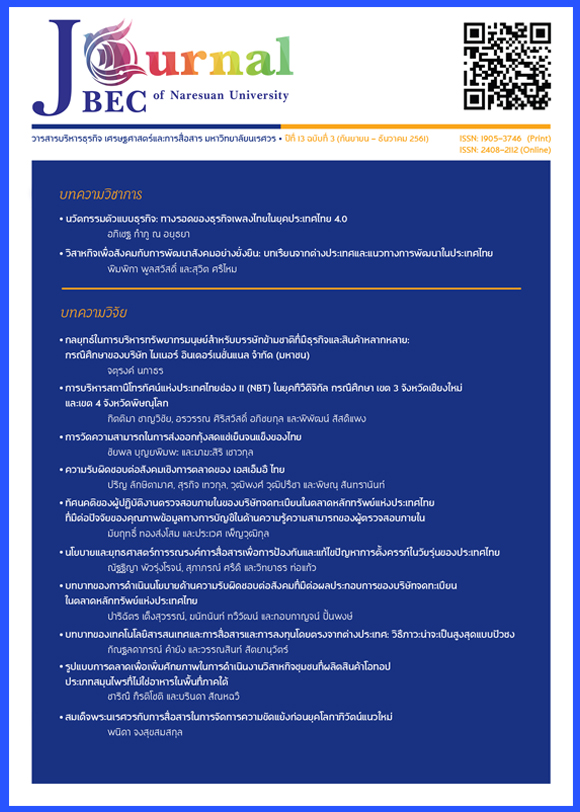วิสาหกิจเพื่อสังคมกับการพัฒนาสังคมอย่างยั่งยืน: บทเรียนจากต่างประเทศและแนวทาง การพัฒนาในประเทศไทย
Main Article Content
บทคัดย่อ
บทความนี้มีวัตถุประสงค์เพื่อนำเสนอวิสาหกิจเพื่อสังคมในฐานะที่เป็นการดำเนินธุรกิจรูปแบบหนึ่งที่ทำให้เกิดการพัฒนาสังคมอย่างยั่งยืน โดยการวิเคราะห์แนวคิดและนำเสนอกรณีตัวอย่างในต่างประเทศและตัวอย่างการนำแนวคิดดังกล่าวมาใช้ในประเทศไทย การดำเนินธุรกิจในลักษณะวิสาหกิจเพื่อสังคมถึงแม้จะมีพันธกิจที่ต่างกัน แต่มีองค์ประกอบหลักเหมือนกัน ได้แก่ การมีเป้าหมายเพื่อสังคมเป็นจุดเริ่มต้น การแก้ไขปัญหาของสังคมและสร้างมูลค่าเพิ่มแก่สังคม การสร้างความยั่งยืนทางการเงิน และคนในสังคมมีส่วนร่วมเป็นเจ้าของ วิสาหกิจเพื่อสังคมสะท้อนให้เห็นคุณค่าที่แต่ละสังคมสามารถนำไปใช้เป็นแนวทางในการแก้ไขปัญหาและพัฒนาสังคมโดยไม่รอความช่วยเหลือจากภาครัฐหรือหน่วยงานอื่น ๆ เท่านั้น ตัวอย่างของวิสาหกิจเพื่อสังคมทั้งต่างประเทศและในประเทศไทยทำให้เกิดการสร้างสังคมที่ดี และทำให้เกิดการพัฒนาสังคมที่ยั่งยืนได้
Article Details
References
2. Anderson, K. (2013). Agricultural price distortions: Trends and volatility, past and prospective.
Agricultural Economics, 44(1), 163-171.
3. Austin, J., Stevenson, H. and Wei-Skillern, J. (2006). Social and commercial entrepreneurship:
Same, different, or both?. Entrepreneurship Theory and Practice, 30(1), 1-22.
4. Baum, J. C. and Oliver, C. (1991). Institutional linkages and organizational mortality. Administrative Science Quarterly, 36(2), 187-218.
5. Carroll, A. B. (1979). A three-dimensional conceptual model of corporate performance. Academy of Management Review, 4(4), 497-505.
6. Colby, S., Stone, N. and Carttar, P. (2004). Zeroing in on impact. Stanford Social Innovation Review, 2(2), 24-33.
7. Community Development Department. (2017). Social enterprise certification. Retrieved
December 2, 2017, from https://www.cdd.go.th/content/download/announce
8. Crane, A., Matten, D. and Moon, J. (2008). Ecological citizenship and the corporation: Politicizing the new corporate environmentalism. Organization and Environment, 21(4), 371-389.
9. Dey, P. and Steyaert, C. (2012). Social entrepreneurs: Critique and the radical enactment of the social. Social Enterprise Journal, 8(2), 90-107.
10. Dees, J. G., Emerson, J. and Economy, P. (2002). Enterprise nonprofits: A toolkit for social entrepreneurs. New York: Wiley
11. Defourny, J. and Nyssens, M. (2010). Conceptions of social enterprise and social entrepreneurship in Europe and the United States: Convergences and divergences. Journal of Social Entrepreneurship, 1(1), 32-53.
12. Elkington, J. (1998). Cannibals with forks: The triple bottom line of 21st- century business. Environmental Quality Management, 8(1), 37-51.
13. Emerson, J. (2003). The blended value proposition: Integrating social and financial returns.
California Management Review, 45(4), 35-51.
14. Fowler, A. (2000). NGDOs as a moment in history: Beyond aid to social entrepreneurship or
civic innovation?. Third World Quarterly, 21(4), 637-654.
15. Golden Place. (2016). Company profile. Retrieved December 10, 2016, from https://www.
suvarnachad.co.th/history.php
16. Haski-Leventhal, D. and Mehra, A. (2016). Impact measurement in social enterprises: Australia
and India. Social Enterprise Journal, 12(1), 78-103.
17. Haugh, H. (2007). Community-led social venture creation. Entrepreneurship Theory and
Practice, 31(2), 161-182.
18. Irodori. (2018). About “Irodori” farmers/social enterprise. Retrieved March 15, 2018, from
https://www.irodori.co.jp/asp/nwsitem.asp?nw_id=8145
19. Jiao, H. (2011). A conceptual model for social entrepreneurship directed toward social impact
on society. Social Enterprise Journal, 7(2), 130-149.
20. Juyjingan, J. and Dhebpanya, P. (2014). Social enterprise: Trend of modern capitalism case studies and best practice applications. Veridian E-Journal Silpakorn University, 7(3), 1229-1242.
21. Khonkaen City Development. (2016). Company profile. Retrieved December 15, 2016, from
https://www.khonkaenthinktank.com/profile.php
22. Khonkaen Municipality. (2016). Strategic development plan in 2017–2020. Retrieved January 10, 2017, from https://center.kkmuni.go.th/index.php/download/file/44-2560-2563.html
23. Kokoboard. (2016). Social environment benefit. Retrieved December 15, 2016, from https://www.kokoboard.com/th/social-environment-benefit-2/
24. Laratta, R., Nakagawa, S. and Sakurai, M. (2011). Japanese social enterprises: Major
contemporary issues and key challenges. Social Enterprise Journal, 7(1), 50-68.
25. Mackett, R. L. and Edwards, M. (1998). The impact of new urban public transport systems:
Will the expectations be met?. Transportation Research Part A: Policy and Practice, 32(4), 231-245.
26. Margolis, J. D. and Walsh, J. P. (2003). Misery loves companies: Rethinking social initiatives by
business. Administrative Science Quarterly, 48(2), 268-305.
27. McGuire, J. B., Sundgren, A. and Schneeweis, T. (1988). Corporate social responsibility and firm financial performance. Academy of Management Journal, 31(4), 854-872.
28. Nag, R. K. (2016). Grameen bank annual report 2016. Retrieved March 15, 2018, from
https://www.grameen.com/wp-content/uploads/bsk-pdf-manager/GB-AR-2016_34.pdf
29. Nakprarop, R. (2016). Social entreprise: Social profit returns concept. Revenue Department
Journal, 6(62), 8-12.
30. Noonin, S. (2014). Organizational analysis: Social enterprise. Journal of Social Sciences
Srinakharinwirot University, 17(1), 358-372.
31. Parrish, B. D. (2010). Sustainability-driven entrepreneurship: Principles of organization design.
Journal of Business Venturing, 25(5), 510-523.
32. Pervez, T., Maritz, A. and Waal, A. D. (2013). Innovation and social entrepreneurship at the bottom of the pyramid - a conceptual framework. South African Journal of Economic and Management Sciences, 16(5), 54-66.
33. Phuket City Development. (2016). About us. Retrieved December 15, 2017, from
https://www.pkcd.co.th/about-us/
34. Pullution Control Department. (2016). Action plan “Zero Waste Thailand” according to the
“Public-Private”. Retrieved December 16, 2016, from https://www.pcd.go.th/Public/News/ GetNewsThai.cfm?task=lt2016&id=17504
35. Rahdari, A., Sepasi, S. and Moradi, M. (2016). Achieving sustainability through Schumpeterian social entrepreneurship: The role of social enterprises. Journal of Cleaner Production, 137, 347-360.
36. Rotheroe, N. and Richards, A. (2007). Social return on investment and social enterprise: Transparent accountability for sustainable development. Social Enterprise Journal, 3(1), 31-48.
37. Sakulsuraekkapong, S. (2016). Factors influencing efficient social enterprise on Thailand. Journal of Politics, Administration and Law, 8(1), 139-161.
38. Siriphattrasophon, S. (2015). A conceptual study of social enterprise development in Thailand. Journal of the Association of Researchers, 20(2), 30-47.
39. Smith, W. K., Gonin, M. and Besharov, M. L. (2013). Managing social-business tensions: A review and research agenda for social enterprise. Business Ethics Quarterly, 23(3), 407-442.
40. Stecker, M. J. (2016). Awash in a sea of confusion: Benefit corporations, social enterprise and the fear of “Greenwashing”. Journal of Economic Issues, 50(2), 373-381.
41. Teasdale, S. (2012). What’s in a name? Making sense of social enterprise discourses. Public Policy and Administration, 27(2), 99-119.
42. Thompson, J. (2011). Reflections on social enterprise and the big society. Social Enterprise Journal, 7(3), 219-223.
43. Waddock, S. A. and Graves, S. B. (1997). The corporate social performance-financial performance link. Strategic Management Journal, 18(4), 303-319.
44. Wongpanit. (2016). About us. Retrieved December 18, 2016, from https://www.wongpanit.com/wpnnew/abountme.php
45. Yangprayong, P. (2016). Managerial analysis of small and micro community enterprise: A case study of Tha Sa An hydroponics. Journal of Business, Economics and Communications, 11(2), 25-32.
46. Yunus, M., Moingeon, B. and Lehmann-Ortega, L. (2010). Building social business models: Lessons from the Grameen experience. Long Range Planning, 43(April-June 2010), 308-325.

